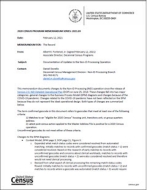Memorandum 2021.03: Documentation of Updates to the Non-ID Processing Operation
Memorandum 2021.03: Documentation of Updates to the Non-ID Processing Operation
This memorandum documents changes to the Non-ID Processing (NID) operation since the release of Version 2.0, NID Detailed Operational Plan (DOP) on June 25, 2018. These changes fall into two major categories: general changes to the Business Process Model (BPM) diagrams and changes because of the COVID-19 pandemic. Changes related to the COVID-19 pandemic have not been reflected on the BPM because they do not represent the ideal operational design. Both types of changes are summarized below.
The term confirmed geocode in this document refers to geocodes that meet at least one of the following criteria:
- Matches to an “eligible for 2020 Census” housing unit, transitory unit, or group quartersaddress.
- Latest post-census action applied to the Master Address File is positive for a 2020 Censusoperation.
Unconfirmed geocodes do not meet either of these criteria.
Changes to the BPM diagrams:
- Context Model, BPM page 3; DOP page 21, Figure 3:
- Expanded what match status codes were considered resolved from automated matching. Initially matches to records with confirmed geocodes (match status = 1) were considered resolved. Based on the research of early matches to records with unconfirmed geocodes and concerns about clerical workloads, matches to records with unconfirmed geocodes (match status = 2) were also considered resolved and therefore would not need clerical processing.
- Revised from what aspect of clerical processing the remaining match status codes flowed. Initially matches to records with unconfirmed geocodes (match status = 2) and matches to records where a geocode was automated (match status = 3) would require verification in Office-Based Address Verification (OBAV). Unmatched and ungeocoded records (match status = 0), matches to records where a geocode was not obtained (match status = 4) and unmatched where a geocode was automated (match status = 5) were sent to manual matching and geocoding in an attempt to match and/or geocode. Because of changes to automated resolutions (described previously) and limited changes to unmatched, geocoded records in manual matching and geocoding, matches to records with unconfirmed geocodes were no longer sent to OBAV, and unmatched but geocoded records were sent to OBAV instead of manual matching and geocoding.
- Decision 25, after activity 20, now sends return code = 1 or 2 (was only 1 before) to activity 70, return code = 3 or 5 (was 2 or 3 before) to activity 40, and return code = 0 or 4 (was 0, 4, or 5 before) to activity 30. Decision 35, after activity 30, redefines Yes as return code = 3 or 5 (was 2, 3, or 5 before) and No as return code = 0, 1, 2, or 4 (was 0, 1, or 4 before).
- 30.80 Perform Quality Control, BPM page 8; DOP page 36, Figure 18 (13-2.2.3 only):
- In the previous version of the BPM is was not clear that Quality Control (QC) was performed for both manual matching and geocoding and OBAV.
- Clarified that 30.80 applies to both 13-2.2.3 Perform Non-ID Quality Control and 13-2.3.1.1 Perform Non-ID Quality Control (new).
- 40 Perform Office-Based Address Validation (OBAV), page 11; DOP page 37, Figure 19 and page 38, Figure 20:
- In previous version of the BPM details for selecting cases for QC was not included for OBAV.
- Added decision 40.25 (Case Selected for QC?) and activity 30.80 (Perform Quality Control) prior to the existing End Subprocess. Decision 40.25 sends cases that were selected for QC (Yes) to activity 30.80 and cases that were not selected for QC (No) to End Subprocess.
COVID-19 Pandemic Related Changes:
- Removing “30.60 Contact the Respondent” from “30 Perform Manual Non-ID Processing”: Because of a need to optimize the clerical process, the Non-ID Processing team evaluated the impact of phone calls on resolving records. Research showed that phone calls were not having a large enough impact to justify the additional time required because this process ultimately took time away from clerks working other records. The decision to remove this step was agreed to by the Non-ID Processing team in April 2020.
- Automating “40 Perform Office-Based Address Verification (OBAV)”: Because of the need to emphasize manual matching and geocoding, the decision was made in August 2020 to automate Office-Based Address Verification (OBAV) and rely on Field Verification (FV) to verify any unmatched Non-ID cases. Based on research into the results of previously worked OBAV cases, it was determined that automated processing could account for records that matched to the address frame in previous processing. Also, the Nonresponse Followup (NRFU) operation was able to process an increased number of FV cases (unmatched). This allowed Non-ID Processing to rely less on clerical processing and instead shift the workload to NRFU without sacrificing accuracy.
The 2020 Census Memorandum Series
The 2020 Census Memorandum Series documents significant decisions, actions, and accomplishments of the 2020 Census Program for the purpose of informing stakeholders, coordinating interdivisional efforts, and documenting important historical changes.
A memorandum generally will be added to this series for any decision or documentation that meets the following criteria:
- A major program level decision that will affect the overall design or have significant effect on 2020 Census operations or systems.
- A major policy decision or change that will affect the overall design or significantly impact 2020 Census operations or systems.
- A report that documents the research and testing for 2020 Census operations or systems.
Visit 2020census.gov to access the Memorandum Series, the 2020 Census Operational Plan, and other information about preparations for the 2020 Census.
Related Information
-
PublicationMemorandum 2018.15: Release of the Non-ID Processing Operational PlanThis memorandum documents the release of the 2020 Census Non-ID Processing Detailed Operational Plan.
-
2020 Census Operational Plan and Detailed Operational PlansThe U.S. Census Bureau’s 2020 Census Operational Plan documents the design for conducting the 2020 Census.
Others in Series
Publication
Publication




